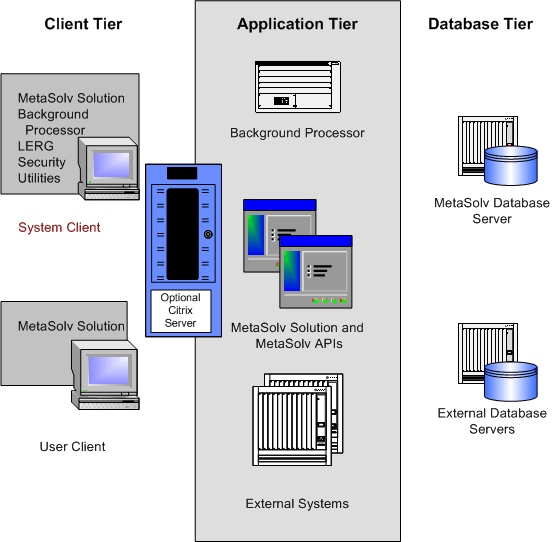1 Introduction
Oracle Communications MetaSolv Solution (MSS) supports service fulfillment business functions. Each subsystem accesses the MetaSolv Solution database and can be extended to support unique products and services.
The MetaSolv Solution application programming interfaces (API) give third-party applications limited access to parts of the MetaSolv Solution database. Additional accessory software may also be purchased.
Managing MetaSolv Solution Administration
In general, the responsibilities of the MetaSolv Solution administrator role fall into three basic categories, as shown in Table 1-1. These are the tasks described in this document.
Table 1-1 Administrative Responsibilities
| Responsibility | Tasks |
|---|---|
|
Monitoring and maintaining the system |
|
|
Supporting users |
|
|
Managing supporting modules, products, and utilities |
|
Introducing the Architecture
The MetaSolv Solution system consists of three tiers: clients, Oracle WebLogic server and APIs, and database servers. It can also include a Citrix/XenApp terminal that helps manage communication.
Figure 1-1 shows the MetaSolv Solution three-tier architecture:
Figure 1-1 MetaSolv Solution Three-Tier Architecture

Description of ''Figure 1-1 MetaSolv Solution Three-Tier Architecture''
MetaSolv Solution is installed on clients and an Oracle WebLogic server. The clients access the Oracle WebLogic server and the Oracle WebLogic server accesses a database. Some accessory products, like the MetaSolv Solution Utilities, access the database directly. See the product documentation for detailed instructions about managing:
-
The Oracle WebLogic Server, Oracle WebLogic Server 10.3.1
-
The Oracle database with a Oracle 11gR2client
MetaSolv Solution clients are the user machines that run the MetaSolv Solution software. The client machines access the Oracle WebLogic server running in the middle tier. Clients connect to these servers using HTTP or IIOP (both over TCP/IP). The Oracle WebLogic server connects to the database server using JDBC connection pools. The APIs run on the Oracle WebLogic server and makes direct JDBC connections to the database. JacORB 2.3.1 is compliant with OMG CORBA 2.3 or higher.
Details about using the Oracle WebLogic server can be found in the server product documentation. This document provides Oracle WebLogic server details only for information unique to the MetaSolv Solution.
The Oracle WebLogic server and the APIs access the MetaSolv Solution database, an Oracle Enterprise Edition 11gR2 database that must reside on a Windows or Unix-based machine.
Installed, the core product consists of many files, most of which require no attention. See "Understanding Configuration Files" for information about the INI and XML configuration files and the EXE files.
Additional files may be installed when MetaSolv Solution is installed, such as the LERG product files. See "Introducing the Accessory Applications" for more information.
See MetaSolv Solution Planning Guide for details about various components and their technical requirements
Introducing the Accessory Applications
In addition to the base MetaSolv Solution product, your company may have purchased an accessory package, called a software option. Also, additional products, such as utilities, are delivered with MetaSolv Solution at no extra cost. Some of these applications run separately and are not normally used by end users. You can change a client Start page to permit access to an accessory product by following instructions in "Enabling Users to Access Accessory Products".
Table 1-2 lists accessory applications that may be loaded on client machines.
Table 1-2 Accessory Options and Products
| Product | Description |
|---|---|
|
APIs |
MetaSolv Solution offers a robust library of APIs that permit interfacing with third-party systems. |
|
Data Selection Tool |
Oracle's Data Selection tool facilitates the selective migration of data between MetaSolv Solution databases of the same version. |
|
MetaSolv Solution Utilities |
Purge Utility – This utility removes old data from database. Database Health Function – This tool runs checks to make sure that all database objects, required by MetaSolv Solution, are valid. Structured Formats – These tools provide a way to enter, define, and store custom formats and valid values for addresses, telephone numbers, switch prefixes, and Local Service Ordering Guide (LSOG) columns. Custom Attributes tool – This tool lets you set up custom attributes to collect and compute data at specific processing points. Migration tool – This tool allows you to create and convert network elements and to migrate pre-5.1 connections, Virtual Layout Records, and reconcile design lines to Release 6.2.1. |
|
Location and Routing Gateway |
The Location and Routing Gateway provides the interface between the MetaSolv Solution and the information from Telcordia Technologies Local Exchange Routing Guide (LERG) for North America, automating the loading of the LERG information into the MetaSolv Solution. The automated process provided by this gateway reduces data entry time and ensures that MetaSolv Solution information is accurate and in compliance with Telcordia standards. |
|
NPA/NXX Split Utility Tool |
The Number Plan Administration (NPA) NXX Split Utility enables you to update your database whenever an NPA (Area Code) split occurs in your service area. MetaSolv Solution uses NPAs as a part of telephone numbers in several functional areas. |
|
Operational Reports |
Oracle's Operational Reports allow you to report on data in the MetaSolv Solution, facilitating the integration of business processes and information across functional areas of your organization. |
Additional Oracle products may also be in use at your site. Log on to the Oracle software delivery website to access those products.